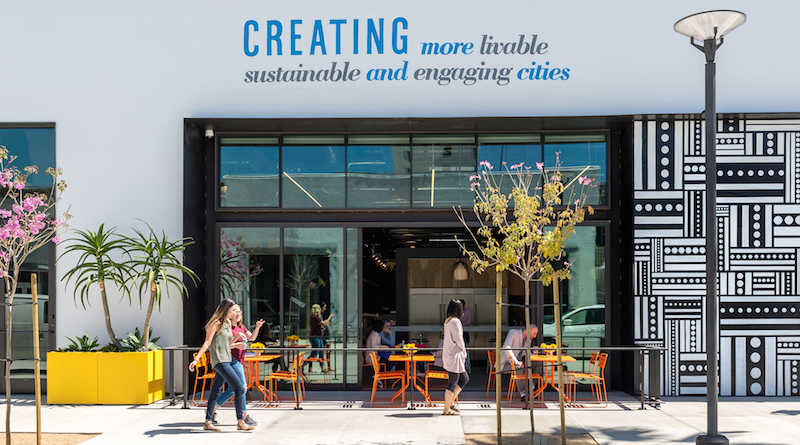By Sara Hickman
The labor market is hot, and executives are quickly learning that attracting and retaining talent is a major challenge. Prospective employees have a savvy understanding that workspaces and office culture — the settings where they spend most of their time — play a critical role in our daily lives. As a result, the architectural buzzwords of 2017 have evolved from creative, collaborative and innovative to health, productivity and quality. Today, we see four key trends in the world of sustainability: design and construction, health and wellness, urban density and community, and corporate responsibility reporting.

Green Building Is Maturing
Over the past 16 years, we have witnessed green building fully mature as an industry. The most prominent green building certification, LEED, is now commonplace having certified nearly 850 million square feet in 2016. As we continue to see LEED certifications become the new norm, health and wellness are becoming the new basis for policy and measure for performance. Created by the International WELL Building Institute (IWBI), the WELL Building Standard debuted in 2014, and there are now more than 30 WELL-certified projects, with 400 more projects registered. In addition to WELL, Fitwel, a product of the Center for Active Design (a brainchild of the Center for Disease Control and Prevention and the General services Administration), publicly unveiled its own standard in February 2017. Fitwel is growing fast with more than 150 current projects and 600 committed through 2018. Fitwel was also recently recognized by Fast Company as one of 2017’s Top 10 Innovative Company in Social Good.
Climate Action Planning & Urban Planning
Another trend we are seeing is climate action planning and urban planning geared toward resiliency at a district level. Enacted in 2008, SB 375, the Sustainable Communities Act, supports the state’s climate action goals to reduce greenhouse gas emissions through coordinated transportation and land-use planning. With deadlines of 2020 quickly approaching, we are starting to see communities who have not yet developed plans quickly taking the necessary steps toward completion. EcoDistricts is a useful tool and certification that advances district-sized projects by zeroing in on equity, resilience and climate protection from the start.
Global Reporting Initiatives & Corporate Responsibility
 Global reporting initiatives and corporate responsibility reporting have skyrocketed in the past five years in both the private and public sectors. Global Real Estate Sustainability Benchmarking (GRESB) grew to 707 participants during that time and accounted for $6.1 trillion in capital worldwide in 2015. The Global Reporting Index (GRI) grew to more than 10,000 organizations last year. We are also increasingly seeing retailers such as Target, Walmart and H&M instituting their own forms of environmental governance reporting. These reports frequently pull directly from a lengthy list of tools and certifications, as listed in this graphic.
Global reporting initiatives and corporate responsibility reporting have skyrocketed in the past five years in both the private and public sectors. Global Real Estate Sustainability Benchmarking (GRESB) grew to 707 participants during that time and accounted for $6.1 trillion in capital worldwide in 2015. The Global Reporting Index (GRI) grew to more than 10,000 organizations last year. We are also increasingly seeing retailers such as Target, Walmart and H&M instituting their own forms of environmental governance reporting. These reports frequently pull directly from a lengthy list of tools and certifications, as listed in this graphic.
Putting It Into Practice
As the sustainability director for Retail Design Collaborative (RDC) & Studio One Eleven, an architectural firm based in Long Beach, Calif., with offices globally, I have been in the driver’s seat of putting into practice these trends in sustainability. However, being at the forefront of our architectural studios green practices, I know we needed to look at the long-term impact of our environmental footprint as our firm transformed a vacant Nordstrom Rack into a vibrant 34,000-plus-square-foot creative office space.
Located on the ground floor level, the studio has direct access to the street. Large windows and outdoor patios create an indoor/outdoor experience, and 20 skylights offer natural daylight and reduce artificial lighting requirements while increasing energy efficiency. The relocation of our office was predicated on the aspiration to create an open, comfortable and collaborative work environment. The adaptive-reuse project confirms our firm’s belief in environmentally sustainable and responsible design by implementing numerous strategies such as engaging natural daylight, natural ventilation, lighting controls for energy conservation, low water consumption, smart material selection and recycled indoor/outdoor green spaces.
We are excited to announce that we are now a LEED Platinum–certified space, and are currently at the tail end of our WELL Certification. We are currently pursuing zero-energy certification by installing a 2-MW solar roof system. We see our space as a living lab. Our culture is constantly evolving, just as we are, and it is important that we take the time to learn from these opportunities and share with the world.
The Future
In closing, smart companies that care about their employees also care about their productivity and, ultimately, the business. These companies are implementing solutions that not only help pave the way for the health of their employees, but also their impact on the planet.
Now more than ever in today’s competitive marketplace, attracting and retaining talent is critical. Businesses that focus on all four components of sustainability — design and construction, health and wellness, urban density and community, and corporate responsibility reporting — are well on their way to creating an environment that is not only one that will continue to attract and retain talent but, for the long-term, will make major strides in sustainability now and for the future.
Sara Hickman is the sustainability director for Retail Design Collaborative & Studio One Eleven.


